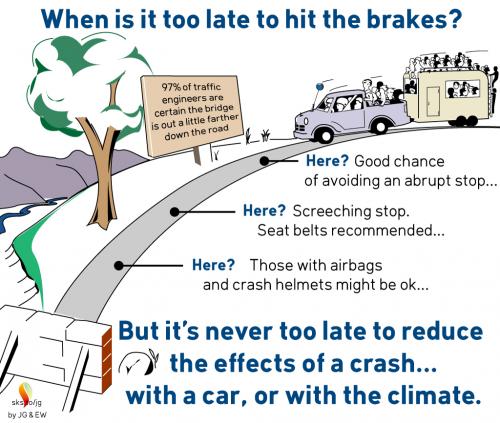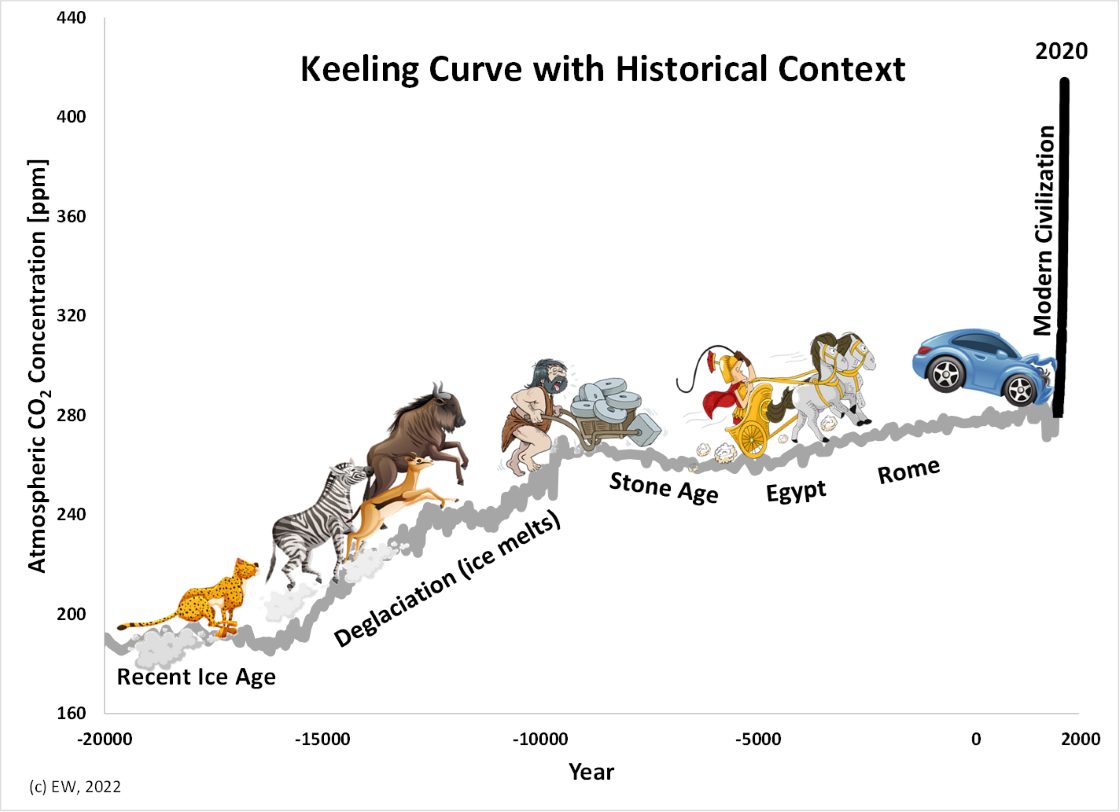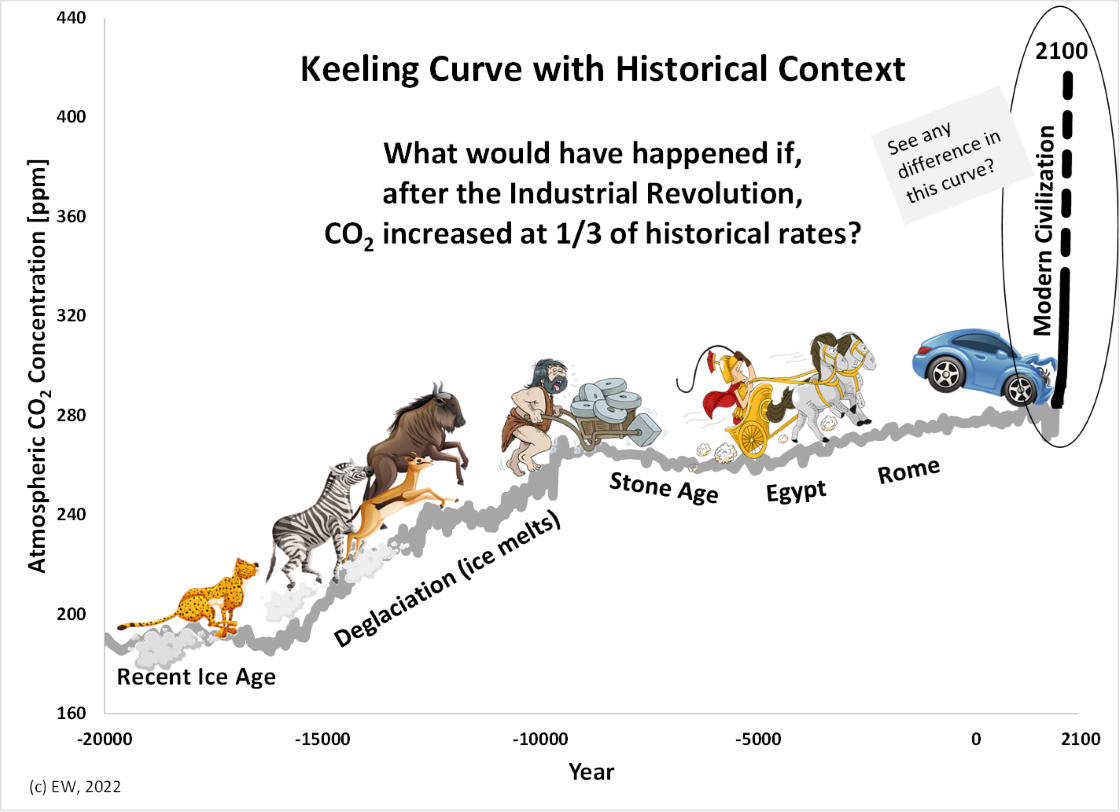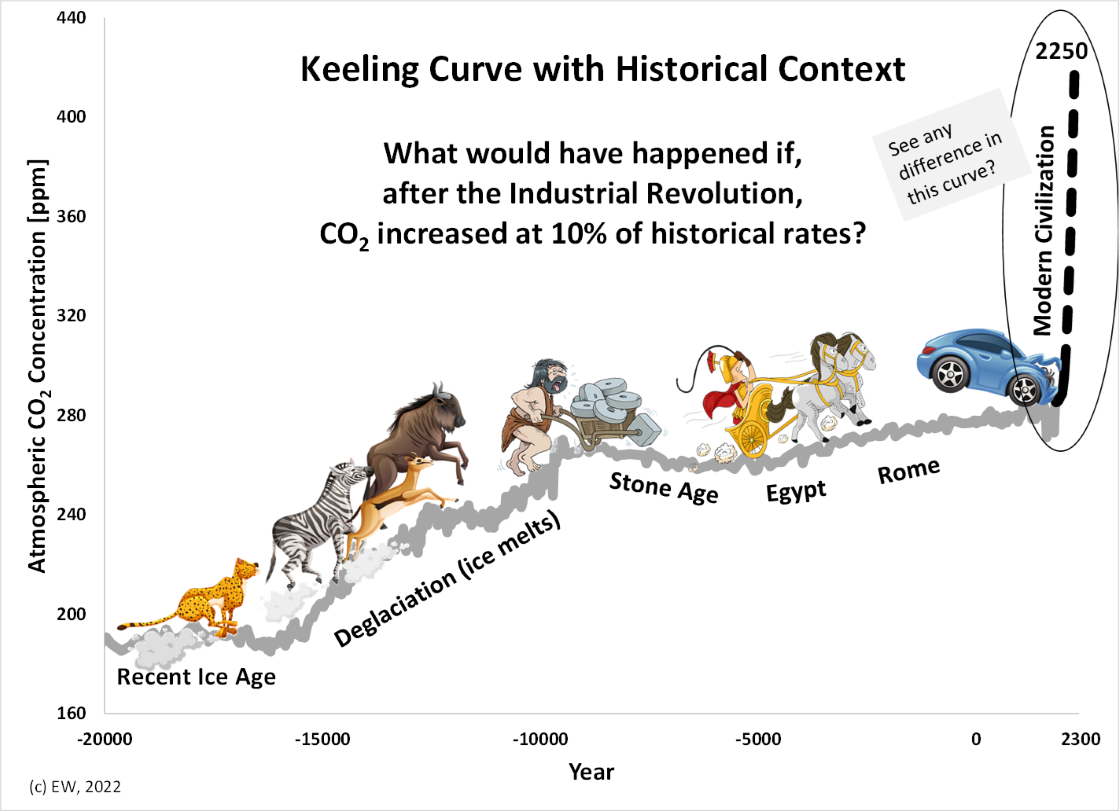SkS Analogy 1 - Speed Kills: How fast is too fast?
Posted on 28 January 2022 by Evan, jg
Tag line
How fast is too fast?
Elevator Statement
While driving down a road you get distracted and look down. When you look up, you see a brick wall directly in front of you blocking the road, because the bridge ahead is out. No matter what you do, you will hit the wall. What can you do to minimize the damage to your car and to its occupants?

Climate Science
Increasing atmospheric CO2 concentrations drive global warming. Global warming drives climate change. The rate of increase of CO2 is important because it determines the rate of global warming, and therefore the rate at which natural systems must adapt to a changing climate. Figure 1 shows CO2 concentrations from the end of the recent ice age to the present. Think of Fig. 1 as the Keeling Curve with historical context, illustrating how rapidly CO2 is rising relative to the most recent deglaciation rate. If we limit the rate of increase of CO2 to that experienced during a deglaciation cycle, we expect nature will adapt; the further away we move from this base rate the more difficult it is for nature to adapt, because rapid rises of temperature are often associated with extinction events.

Figure 1. Rate of increase of CO2 relative to the rate during the recent deglaciation. The range of the Keeling Curve is indicated by the bracket. The animals running up the CO2 "hill" indicate that nature can adapt to this rate of change. A stable CO2 level provided a relatively stable climatic base for the development of modern civilization. Can modern civilization surmount the CO2 cliff in front of us? (Clipart licensed from iStock/skalapendra (car), iStock/blueringmedia (herd), Getty Images/zaricm (caveman), and 123RF/Lorelyn Medina (chariot))
One of the many reasons that the rate of warming matters to modern civilization is that during the relatively slow warming of the last deglaciation, there was a period when sea level rose 1 ft/10 years for a period of about 300 years or so!1 With over 200 ft of sea-level rise locked up in the world’s ice, at rates of warming even a fraction of what they are now, it is likely that we will trigger similar rates of sea-level rise. How much would we have to lower our CO2 emission rate to make them comparable to, or less, that the rates during the recent deglaciation?
What if historical rates had been 1/3 of observed rates?
We can get some idea of the scale of the problem by playing what-if scenarios with the CO2 concentrations from the start of the Industrial Revolution (i.e., roughly 1800) onward. For example, what if we could go back in time and make changes to agricultural practices, changes to industrial efficiency, and changes to the way people use power such that atmospheric CO2 concentrations increased at 1/3 the observed rate? What would that look like? Figure 2 shows such a scenario, played out until CO2 rises to about the same level it is in 2020.2 Although rising at only 1/3 the actual rate, it only takes until 2100 to get to 420 ppm CO2. The CO2 cliff appears much as it does in Fig. 1. It is simply shifted to the right by decades.

Figure 2. Rate of increase during the “Modern Civilization” era, for a rate of increase 1/3 the actual rate. Beyond 2020 the rate of increase is based on an extrapolation of the rate of increase of the Keeling Curve from 1960-2020 (the extrapolated part is shown as a dashed line).
What if historical rates had been 10% of observed rates?
What if we reduce the rate to 10% of the observed rate? That is, what if wind turbines, electric vehicles, and a host of other low-emission technologies had been developed soon after the Industrial Revolution, and broadly adopted, such that GHG emissions were 10% of what they actually were? Figure 3 shows the result of this exercise, plotted until CO2 rises to 420 ppm.3 Even this vastly reduced rate is still much faster than during the deglaciation cycle at the end of the recent ice age.

Figure 3. Rate of increase during the “Modern Civilization” era, for a rate of increase 10% the actual rate. Beyond 2020 the rate of increase is based on an extrapolation of the rate of increase of the Keeling Curve from 1960-2020 (the extrapolated part is shown as a dashed line).
Figures 1 to 3 indicate that compared to the recent deglaciation, any "reasonable" decrease in the growth rate of CO2 does not change the fact that we are running into a cliff. What the decreased rates do is to reduce the rate at which we run into the cliff. That has some benefit as a delaying action, as long as we use the delay to mitigate the effects of running into the cliff.
Think of these plots the next time somebody tries to get you excited about a 10 or 20% decrease in carbon emissions associated with this or that new technology. Think about these plots when somebody notes that the carbon emissions from burning natural gas are only 50% what they are from burning coal. Figures 2 and 3 indicate that even carbon-emission reductions of 300 to 1000%, not just from a single technology but across the entire Earth, are still inadequate to reduce the growth rate of carbon to a level to which we have confidence that the natural world and modern civilization can adapt. The only level of carbon emissions about which we have any hope for maintaining a stable, modern civilization is Net Zero carbon emissions.
Hopefully these examples give you a better feel for why climate scientists and the IPCC are stressing the need to achieve Net Zero emissions by 2050. The goal is that from 2050 on that CO2 concentrations stop rising, and maybe even decrease somewhat. But what if we don’t quite achieve Net Zero emissions by 2050? What then?
This is not a matter of all or nothing. Your smart phone is a clear example that humans are extremely creative and inventive. But we need time to develop new science and time to deploy new technology that embodies that science. Any reduction in GHG emission rates buys us much needed time to adapt to changes that are already impacting us, and to deploy solutions for minimizing future impacts. Everything you do to reduce GHG emissions buys us more time to develop and to deploy climate solutions. But ultimately, the only real solution is to achieve Net Zero emissions.
Footnotes
1. That is, during Meltwater Pulse 1A.
2. To extrapolate beyond 2022, the shape of the Keeling Curve was extrapolated at 1/3 the rate it increased from 1960 to 2020, until CO2 rose to 420 ppm.
3. To extrapolate beyond 2022, the shape of the Keeling Curve was extrapolated at 10% the rate it increased from 1960 to 2020, until CO2 rose to 420 ppm.































 Arguments
Arguments






























This comment includes some repetition, but here are my thoughts, as an ethical engineer, regarding the ‘speed’ of ‘sea level rise’.
I started reading Chapter 13 of the IPCC AR5 WG2 Report hoping to find a reasonable indication of the amount of sea level rise that is likely per degree C of global warming impact. There are many complications, not the least of which is how long the temperature remains warmer after human activity impacts stop causing increased GHG concentrations.
Chapter 13 includes the following: “For the period 2081–2100, compared to 1986–2005, global mean sea level rise is likely (medium confidence) to be in the 5 to 95% range of projections from process-based models, which give 0.26 to 0.55 m for RCP2.6”. And there would be additional sea level rise after 2100 in RCP2.6. Chapter 13 also provides the following low end estimate of future sea level rise: “The few available process-based models that go beyond 2100 indicate global mean sea level rise above the pre-industrial level to be less than 1 m by 2300 for greenhouse gas concentrations that peak and decline and remain below 500 ppm CO2-eq, as in scenario RCP2.6.”
That leads to understanding that there is a significant lack of certainty regarding the consequences of human climate change impacts. But the low end of possible impacts is significant, especially the uncertainty regarding the end magnitude of the climate change impacts. That means there is currently significant uncertainty regarding what the final changes that have to be adapted to will be when humans stop causing accumulating climate change impacts.
As an engineer I, and hopefully other engineers, would take the position that actions causing highly uncertain risk of harm should not be continued, and should be rapidly decreased, ideally being stopped immediately. Continuing or increasing the activities that are producing the understandably harmful accumulating impacts would not be allowed by responsibly engineers until the uncertainties are significantly reduced. That is the ethical position to take when faced with high uncertainty regarding the need to ensure that there is an acceptably low chance of harmful results.
From an responsible ethical engineer’s perspective, even if a structure is built and being used, as soon as the potential risk of a significant harmful result is identified the responsible thing to do is to stop using the structure until the risk of harm is reduced to an acceptable low level. A common safety level for structure design codes is to have less than a 2% chance of a harmful result.
Returning to the Chapter 13 point above, the sea level rise for 5% chance of harm is 0.55 m by 2100 in RCP2.6 with more rise occurring after 2100. Designing seafront developments, and revising existing ones, to have a 98% chance of adequate performance in 2100 would need to be based on more than 0.55 m rise in RCP2.6. And a higher sea level rise would be the required basis for features that are hoped to be sustainable past 2100. And even more sea level rise would need to be the basis if a scenario of higher impact than RCP2.6 occurs.
Going back to the ethical considerations, the beneficiaries of the harmful activities in the current generation have an ethical obligation to ensure that there is only a very small chance that Others, especially future generations, have to expend their effort adapting to climate change impacts they did not significantly benefit from the creation of. And the people benefiting cannot be trusted to do the evaluation of the risk and magnitude of harm done.
Given the significant uncertainties of the harm being done by climate change impacts, a significant amount of ‘corrective action’ is required from those who benefit(ed) most from the harm being done. And that corrective action includes rapidly reducing how much they benefit from the harmful activity. And ‘self interest’ would powerfully motivate the beneficiaries of the harmful action to incorrectly evaluate the risk and magnitude of harm done.
And, regarding the adaptations that current humans should be making to reduce the harmful need for future adaptation, the ethical understanding is that it is harmful for current day people to benefit from living in ways that future generations cannot continue, with the related ethical understanding that requiring future generations to adapt to future changes, which is a distraction from pursuing sustainable improvements, is harmful to them.
The development of sustainable improvements for the future of humanity requires a reasonable certainty of the maximum magnitude of climate change impacts, not just a slower rate of change. A massive amount of human development, especially things like food production in the Bangladesh delta region, is at risk of harmful impact from sea level rise. And some of it is already seriously harmed by the 0.3 m sea level rise that has occurred over the past 100 years.
Also, it is important to note that there are other harmful impacts of climate change that deserve consideration. The discussion of sea level rise should be clarified to be only one of many harmful impacts of climate change. Believing it is possible for future generations to ‘deal with’ 0.3 m sea level rise every 100 years is incorrect by itself. When all the other harmful impacts of climate change are considered, the acceptability of far lower rates of climate change being imposed on future generations can be understood to be unacceptable.
............
So, the concern about sea level rise is far more than a concern about the rate of change. Admittedly, if the rate of change due to human action was less than 0.3 m in 1000 years it could be argued that rebuilding or adapting human development could potentially be expected to ‘keep pace’. But even that ‘ability to adapt’ has to come with an admission that some things that could last for 1000 years or more would be ruined by the human caused sea level rise. It also has to be admitted that ‘accepting human imposed sea level rise, or other climate change impacts’ also requires the admission of the need for current day humans to rapidly transition to sustainable ways of living, including revision of things that have already been developed in order for them to be sustainable.
Without rapid transition to sustainable development, seaside developments would have to be rebuilt constantly, a major distraction from sustainable development efforts. That would be more than just replacing buildings. It would include completely relocating developed areas and features like sewage collection and treatment systems.
That understanding leads to an engineering solution I am fond of pointing out. If someone asks how they can build a resort area in the mountains to survive potential avalanches, the answer is to not develop anything in areas of the mountains that are prone to avalanches, or to restrict development in avalanche prone regions of the mountains to minor easily rebuilt stuff for short-term use, like day-use. And the related climate change issue is changes of avalanche potential due to climate change. The more rapid and more significant the climate change is likely to be the more restrictions there should be on development in mountain areas. When there is less certainty regarding changes of avalanche risk (uncertainty of the rate of change of risk, or a rapid rate of change, or uncertainty about the ultimate maximum magnitude of change of risk when the human induced climate change is stopped), or uncertainty regarding the actual changes of avalanche risk due to a certain amount of climate change impact, then human development needs to be kept out of larger areas of mountain regions. And already built human developments need to be removed from that larger area.
Considerations of human caused sea level rise leads to similar thinking, recommendations and restrictions for seafront development. Without certainty regarding the peak climate change impacts, seafront regions should be planned to be abandoned. Human development should be kept well back from seafronts and also be kept out of low lying regions that would be subject to future flooding by sea level rise. Those areas should be restricted to temporary development for short-term use. Restricting the seafronts to day-use only would also reduce the risk of storm harm to humans. There would be less need for mass evacuations on short notice. And Project Drawdown led by Paul Hawken and Amanda Joy Ravenhill, and other sources, mention other benefits of undeveloping and rewilding seafront regions.
But the more challenging aspect of the sea level rise or avalanche risk issues, more challenging than revisions of what humans build, is the impacts on more essential human development like food production in river delta regions. That is a ‘more essential’ use of a region that is at risk of being less able to be adapted to suit the regional climate change impacts. A critical understanding is the importance of the need to protect the sustainability of the ‘diversity of regional environments that humans essentially require’ from human climate change impacts. And it leads to the awareness that all harmful human impacts on the environment are a concern because humans can only be certain to survive if they are ‘part of the diversity of life on this amazing planet’. Technology can help. But the environment is essential. And the diversity of life needs a reasonably stable environment, an environment that is not rapidly or significantly changed by human activity.
The UNEP 2022: Emergency mode for the environment, published January 6, 2022, identifies the “... enduring crises of climate change, biodiversity loss, and pollution and waste.” That is far more than climate change. And it all matters, not just climate change.
It is also essential to be aware that the climate change concern is not restricted to sea level rise. There are many different harmful impacts of climate change, not just sea level rise (or changes to avalanche risk).
In closing, developing a sustainable and improving future for humanity does not just mean reducing the rate of climate change impacts. It also requires more than ending climate change impacts. More than Net-Zero by 2050 is required. Limiting the magnitude of the peak impact is key. So ‘slowing down the rate of harm done as rapidly as possible’ is better than ‘going slower on the slowing down of harmful impacts in the unethical hope that more rapid slowing down will be done by Others in the future’. And it is even less ethical to believe and claim that future generations will be able to deal with whatever gets imposed on them.
Post closing: Drawing down CO2 levels to 350 ppm ‘even if drawing down CO2 levels is unpopular or not profitable’ would also be an ethical thing to do. And it is easier to do if the peak climate change impact is smaller.